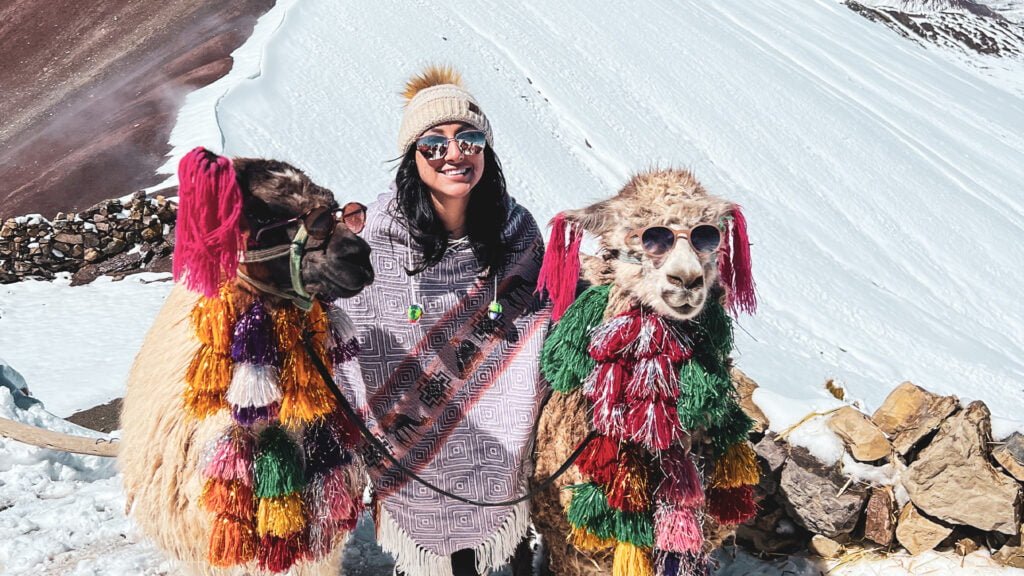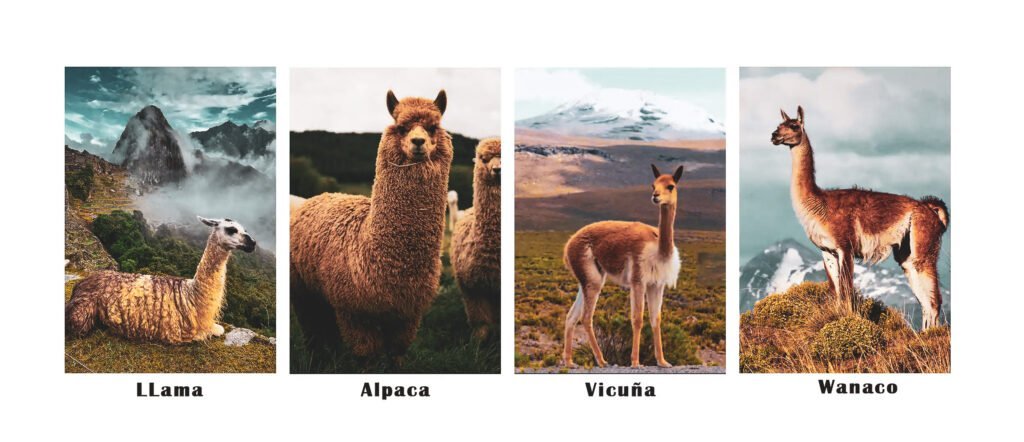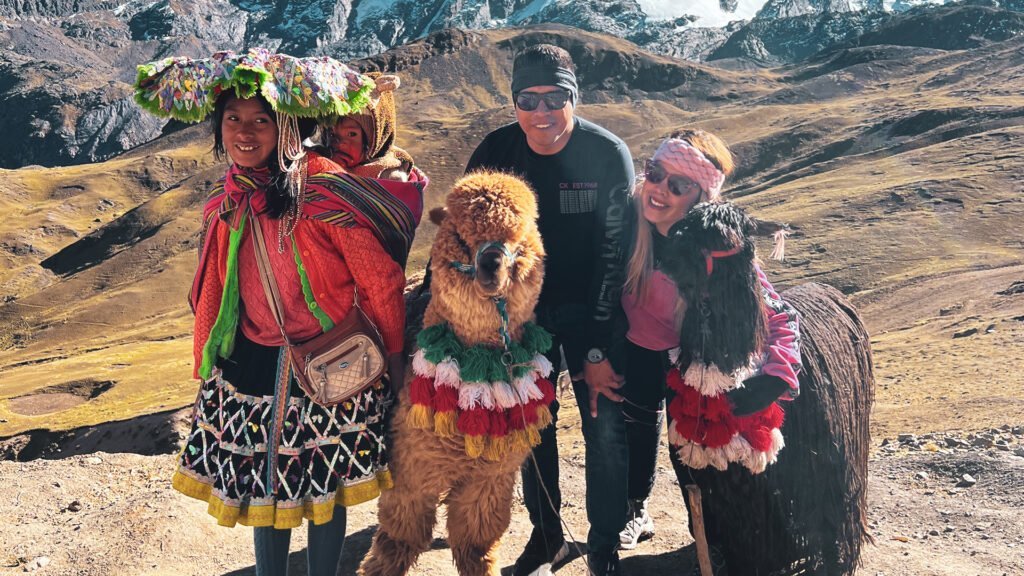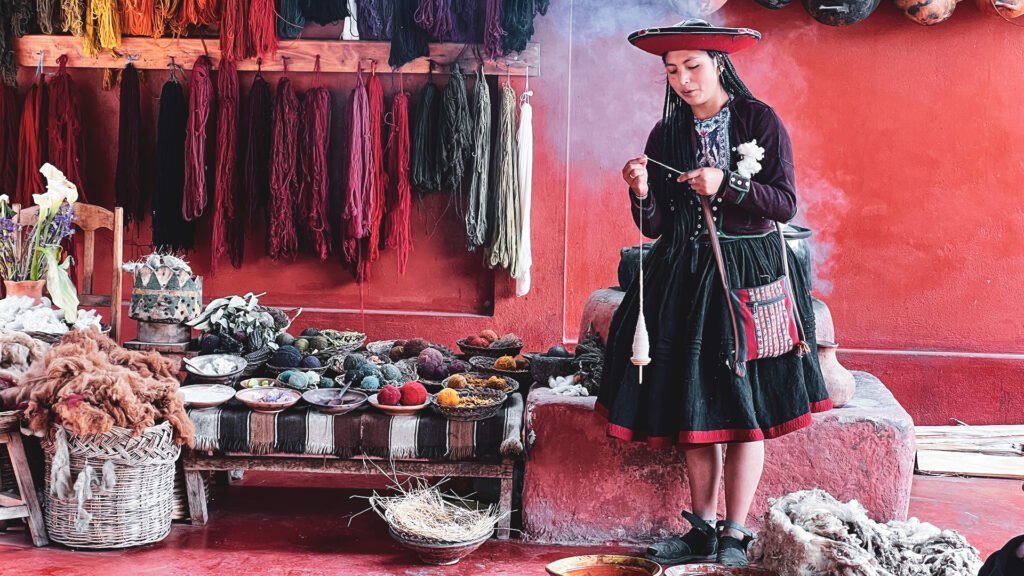In the majestic heights of South America’s Andean mountains, a distinctive family of animals has flourished for millennia. This group, known as camelids, includes the familiar llamas and alpacas, alongside their wild cousins, the vicuña and guanaco. These species embody the resilience and adaptability of Andean wildlife, significantly contributing to the region’s ecological balance, cultural richness, and economic growth in countries like Peru, Ecuador, and Bolivia.
The story of Andean camelids begins over 6000 years ago, with the domestication of the wild guanaco and vicuña by the ancient peoples of the Andes. This transformative process gave rise to the llamas and alpacas we know today, animals specifically bred for their strength, endurance, and valuable fibers. These domesticated camelids quickly became integral to the societies of the Andes, providing not only essential resources such as meat and wool but also serving as symbols of wealth and status.

Llamas, descended from the guanaco, emerged as the pack animals of choice, capable of carrying heavy loads across the rugged mountainous terrain of the Andes. Their larger size and strength made them invaluable to the transportation needs of Andean cultures, facilitating trade and communication across vast distances. In contrast, alpacas, with their ancestry traced back to the vicuña, became prized for their luxuriously soft and hypoallergenic fleece. The fine fibers produced by alpacas were, and continue to be, sought after worldwide for the creation of high-quality textiles.
The vicuña, the wild ancestor of the alpaca, remains one of the most elusive and revered animals in the Andes. With its fine, silky fleece, the vicuña has been protected by law and regarded as a symbol of the Inkan nobility. Similarly, the guanaco, a relative of the llama, persists in the wild landscapes of the Andes, admired for its resilience and beauty.
Throughout history, Andean camelids have not only survived but flourished, despite the challenges posed by the Spanish conquest and the introduction of foreign livestock. These animals adapted to the harsh conditions of the high Andean plains, a testament to their resilience and the careful stewardship of the indigenous peoples who have lived alongside them for millennia.
Nowadays, llamas, alpacas, vicuñas, and guanacos remain central to the Andean way of life. Their contributions extend beyond their economic value; they are key to preserving the biodiversity of their high-altitude habitats. Their gentle grazing prevents overgrowth, helping to maintain the health of the Andean grasslands.

These camelids have not only survived but thrived under the harsh conditions of the Andes, thanks to unique physiological adaptations. Their efficient respiratory systems and specialized blood cells enable them to prosper at high altitudes, underscoring their remarkable adaptability.

Proper shearing is essential for the welfare of the animals and the quality of the fiber. This includes timing the shearing process, employing experienced shearers, and preparing the animals’ fleece beforehand to ensure the best outcomes.
The shearing of vicuñas is regulated and performed during specific times of the year, following traditional methods that ensure the protection of these animals. The Chaccu, an ancient Incan practice, is a communal event where vicuñas are gently rounded up, sheared, and then released back into the wild. This sustainable practice honors the cultural heritage of the Andes while ensuring the vicuñas are not overexploited.
Guanacos are less commonly sheared due to their wild status and the difficulty of handling them. However, when shearing does occur, it follows strict regulations to ensure minimal stress and harm to the animals.

Modern Techniques: For larger scale production, mechanical spinning offers efficiency and uniformity. However, maintaining a gentle process is crucial to preserving the fiber’s natural qualities.
By adhering to these best practices in shearing, dyeing, and spinning, producers can ensure the highest quality of llama, alpaca, vicuña, and guanaco fibers, while respecting the animals and the environment. These practices not only yield superior textiles but also support sustainable and ethical production methods that are in harmony with the rich traditions and natural beauty of the Andes.

In the tapestry of Andean culture, llamas and alpacas are far more than domesticated animals; they are emblematic of resilience, communal harmony, and a profound connection to the Earth. The relationship between these camelids and the indigenous people of Peru, Ecuador, and Bolivia stretches back over 6000 years, predating even the magnificent Inkan Empire. This bond was forged in the rugged terrains of the Andes, where llamas and alpacas became indispensable to survival and prosperity.
The indigenous cultures of the Andes do not merely regard llamas and alpacas as sources of wool and labor. They are seen as blessings from Pachamama (Mother Earth), symbols of prosperity, and markers of social status. Their significance transcends the material, touching the spiritual realm. In rituals and ceremonies, llamas and alpacas are often presented as offerings, reflecting their role as mediators between the human and divine worlds.
The fleece of llamas and alpacas is the foundation upon which the Andean tradition of textile artistry is built. This tradition is not just a testament to the economic importance of these animals but also a vibrant expression of cultural identity and artistic ingenuity. From the soft, luxurious alpaca fleece to the sturdy, versatile llama wool, these fibers are transformed into textiles that narrate stories of the Andean people, their beliefs, and their ancestors.
Moreover, the contribution of llamas and alpacas extends beyond their fleece. Their meat, historically preserved as “charki,” has nourished generations, while their role in agriculture and transportation has shaped the landscape and the way of life in the high Andes.
The reverence for llamas and alpacas is deeply tied to a worldview that respects the interdependence of all living beings. These animals are not only integral to the physical well-being of the Andean communities but also to their spiritual and ecological balance. The careful stewardship of llamas and alpacas reflects an understanding of sustainability and respect for nature that is centuries old, emphasizing the role of humans as caretakers of the Earth.
Llamas and alpacas are integral to maintaining the delicate balance of Andean ecosystems. Their soft-footed presence and grazing habits help preserve the biodiversity of the high-altitude grasslands, preventing overgrazing and promoting the health of these fragile habitats.
The economic importance of llamas and alpacas cannot be overstated. They provide vital resources such as wool, meat, and even transportation, supporting the livelihoods of many Andean communities. Alpaca fiber, in particular, is highly valued on the global market for its softness, warmth, and hypoallergenic properties, contributing significantly to local and national economies.
Beyond their ecological and economic roles, llamas and alpacas are woven into the cultural and spiritual fabric of the Andean people. They are symbols of prosperity and harmony, featured prominently in rituals, festivals, and art. Their historical and ongoing presence underscores their role as a link between the past and present, embodying the traditions and values of indigenous cultures.

As the world shifts towards sustainable practices, the story of llamas and alpacas serves as a reminder of the importance of balancing modern advancements with traditional knowledge and respect for nature. Efforts to conserve these animals and their habitats are crucial for their future survival and the preservation of Andean heritage.
Yes, both llamas and alpacas can be house-trained to a certain extent. Their intelligent and docile nature, especially in the case of alpacas, makes them capable of learning where to defecate and urinate if trained consistently. However, their needs and well-being as herd animals and their requirement for outdoor space must be considered.
Exploring the enchanting world of llamas and alpacas reveals a fascinating journey into the heart of the Andes, where these charismatic creatures play a vital role in the culture, economy, and ecosystems of their native South American highlands. While both animals share a rich history and many similarities, key differences between them cater to various interests and needs, making them beloved by enthusiasts worldwide. Here’s a delightful look into the distinct characteristics and roles of llamas and alpacas, making this information not only readable but thoroughly enjoyable.
Discovering the Charm of Llamas and Alpacas
Unique Features Setting Them Apart
Ears that Tell a Story: The alpaca’s shorter, pointed ears, reminiscent of mythical elves, contrast with the llama’s longer, curved ears, which bring to mind the gentle arc of a banana.
Faces Full of Character: Alpacas wear a look of innocent curiosity, their faces seemingly squished to create an irresistibly cute expression. Llamas, with their pronounced snouts, carry an air of noble confidence, surveying their surroundings with an assured gaze.
A Tale of Two Sizes: In the family of llamas and alpacas, size does matter. Llamas, towering up to four feet at the shoulder and weighing as much as 400 pounds, stand out with their imposing stature. Alpacas, with their more petite frame, stand around three feet tall and weigh about 150 pounds, embodying grace and gentleness.
Fleece as Soft as Clouds: Alpacas are celebrated for their sumptuously soft fleece, sought after by fashion designers and textile artists alike for its hypoallergenic and cozy qualities. Llamas, while also producing a valuable fleece, offer a fiber that is coarser, lending itself well to crafting durable goods and artistic endeavors.
Personality Plus: The Diverse Temperaments of Llamas and Alpacas
Alpacas exude a shy and gentle nature, preferring the companionship of their herd to the spotlight of individual attention. Llamas, on the other hand, showcase a bold independence and can often display a spirited personality, making them excellent guardians for their more reserved alpaca cousins.
Versatile and Valued: The Many Roles of Llamas and Alpacas
Alpacas: Bred primarily for their luxurious fleece, alpacas contribute to a thriving textile industry that spans the globe, offering materials that are as gentle on the skin as they are on the environment.
Llamas: These sturdy animals have carved out their niche as capable pack animals, their strength and endurance making them indispensable companions for traversing the rugged Andean landscapes. Additionally, their fiber finds its place in traditional weaving, adding to the cultural tapestry of the Andes.
The lifespan of a llama generally ranges around 15 to 25 years, while alpacas tend to have a slightly shorter lifespan, typically between 15 and 20 years. These ranges can vary depending on the care, environment, and health management practices in place.
Starting a llama or alpaca farm involves several steps:
Research: Learn about the specific needs, care, and management of llamas and alpacas.
Land and Shelter: Ensure you have adequate land with sufficient grazing space and shelter to protect the animals from harsh weather.
Purchase Animals: Buy llamas or alpacas from reputable breeders who can provide health records and support.
Learn Husbandry Practices: Understand the feeding, breeding, health care, and fiber management of your animals.
Connect with the Community: Join local or national llama and alpaca organizations for support, resources, and networking.
Yes, both llamas and alpacas can be friendly with children and pets if they are socialized properly from a young age. Alpacas, in particular, are known for their gentle and shy nature, making them suitable companions for families. However, individual personalities vary, and supervision is important to ensure safe interactions.
The major differences in fiber quality between llamas and alpacas are:
Softness: Alpaca fiber is generally softer and finer than llama fiber, making it more suitable for clothing and luxury textiles.
Warmth and Hypoallergenic Properties: Alpaca fiber is known for its warmth and hypoallergenic properties, lacking the lanolin found in sheep’s wool, making it less itchy and more comfortable for sensitive skin.
Use: Llama fiber, being coarser, is often used for rugs, ropes, and crafts, whereas alpaca fiber is prized for high-quality garments and accessories.
Understanding these aspects can help you appreciate the unique qualities and considerations involved in living with, caring for, and utilizing llamas and alpacas, whether for companionship, farming, or fiber production.